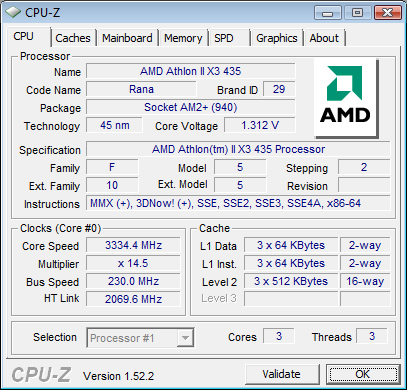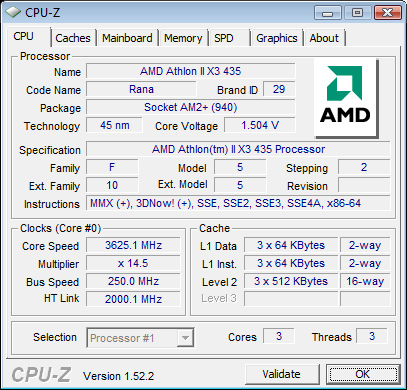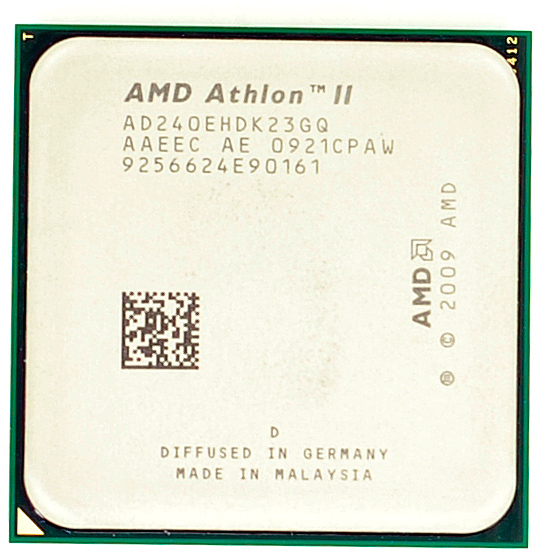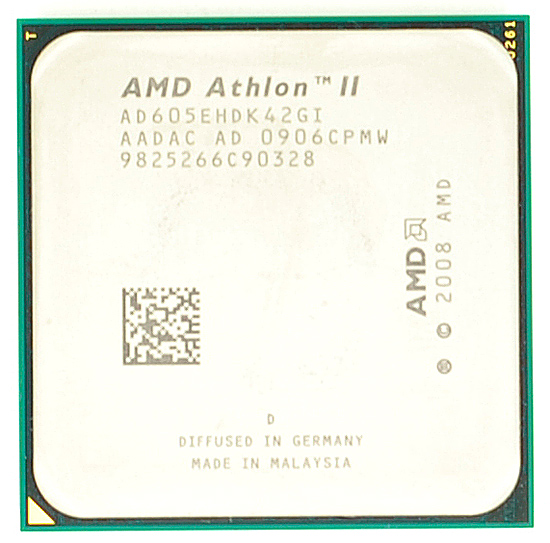AMD's Athlon II X3 435 & New Energy Efficient CPUs: Killing Intel Below $90
by Anand Lal Shimpi on October 20, 2009 12:00 AM EST- Posted in
- CPUs
A month ago AMD introduced the world’s first quad-core processor to debut at $99. Last week, AMD announced its third quarter earnings for 2009. While the company as a whole lost money, the Product Company (CPU and GPU design) turned a small profit. I don’t want to say that the worst is behind AMD, but things are definitely looking up.
| Income | Q3 2009 | Q2 2009 | Q1 2009 |
| AMD | -$128 Million | -$330 Million | -$416 Million |
| AMD Product Company | +$2 Million | -$244 Million | -$308 Million |
And for the consumer, AMD is providing a ton of value these days. You're getting more transistors per dollar than Intel will give you, and it's not just bloat, these things are fast:
| Processor | Cores | Manufacturing Process | L1 Cache | L2 Cache | L3 Cache | Die Size | Transistor Count |
| AMD Phenom II X4 | 4 | 45nm | 128KB per core | 512KB per core | 6MB | 258 mm2 | 758M |
| AMD Athlon II X4/X3 | 4 | 45nm | 128KB per core | 512KB per core | 0MB | 169 mm2 | 300M |
| AMD Athlon II X2 | 2 | 45nm | 128KB per core | 1MB per core | 0MB | 117 mm2 | 234M |
| Intel Core 2 Quad Q8xxx | 4 | 45nm | 64KB per core | 4MB | 0MB | 164 mm2 | 456M |
| Intel Pentium E6xxx | 2 | 45nm | 64KB per core | 2MB | 0MB | 82 mm2 | 228M |
The value train continues with todays introduction of the first triple core Athlon II processors: the Athlon II X3 435 and 425. Clocked at 2.9GHz and 2.7GHz respectively, these processors are simply Athlon II X4s with one core disabled.

They’re also quite affordable. The 435 will set you back $87 while the 425 costs $76. This puts them on par with Intel’s Pentium E6000 series dual core processors, but cheaper than the Core 2 Duo E7500. This has been AMD’s high end dual core strategy for the Phenom’s life: sell three cores for the price of two. And in the past, it has worked.
| Processor | Clock Speed | L2 Cache | L3 Cache | TDP | Price |
| AMD Phenom II X4 965 BE | 3.4GHz | 2MB | 6MB | 140W | $245 |
| AMD Phenom II X4 955 BE | 3.2GHz | 2MB | 6MB | 125W | $245 |
| AMD Phenom II X4 945 | 3.0GHz | 2MB | 6MB | 125W | $225 |
| AMD Phenom II X3 720 BE | 2.8GHz | 1.5MB | 6MB | 95W | $145 |
| AMD Phenom II X2 550 BE | 3.1GHz | 1MB | 6MB | 80W | $105 |
| AMD Athlon II X4 630 | 2.8GHz | 2MB | 0MB | 95W | $122 |
| AMD Athlon II X4 620 | 2.6GHz | 2MB | 0MB | 95W | $99 |
| AMD Athlon II X3 435 | 2.9GHz | 1.5MB | 0MB | 95W | $87 |
| AMD Athlon II X3 425 | 2.7GHz | 1.5MB | 0MB | 95W | $76 |
| AMD Athlon II X2 250 | 3.0GHz | 2MB | 0MB | 65W | $87 |
| AMD Athlon II X2 245 | 2.9GHz | 2MB | 0MB | 65W | $66 |
| AMD Athlon II X2 240 | 2.8GHz | 2MB | 0MB | 65W | $60 |
The X3s AMD is announcing today are clocked high enough that you still have good performance in single threaded applications, and in those that can take advantage of three cores you’re almost guaranteed to have better performance than the Intel alternative.
The real question you have to ask is whether it makes more sense to spend a little more than get a quad-core processor or not.
The Athlon II X3s are 45nm 95W TDP parts and work in both Socket-AM2+ and Socket-AM3 motherboards. As I mentioned before, these are architecturally identical to the X4s just with one core disabled. That means you get a 512KB L2 per core but no L3 cache.
I’ll spoil the surprise for you here: they’re faster than the equivalently priced Intel CPUs in most cases, but that’s not too surprising.
The Athlon II X3 435 is a bit more overclockable than the X4 620. Without any additional voltage we got 3.25GHz on our 620 sample, but our 435 yielded 3.33GHz:

With an extra ~15% voltage we could get 3.63GHz:

AMD is also introducing a slew of energy efficient Athlon IIs as well. They’re all in the table below:
| Processor | Clock Speed | L2 Cache | TDP | Price | Premium |
| AMD Athlon II X4 605e | 2.3GHz | 2MB | 45W | $143 | +$44 |
| AMD Athlon II X4 600e | 2.2GHz | 2MB | 45W | $133 | +$34 |
| AMD Athlon II X3 405e | 2.3GHz | 1.5MB | 45W | $102 | +$26 |
| AMD Athlon II X3 400e | 2.2GHz | 1.5MB | 45W | $97 | +$21 |
| AMD Athlon II X2 240e | 2.8GHz | 2MB | 45W | $77 | +$17 |
| AMD Athlon II X2 235e | 2.7GHz | 2MB | 45W | $69 | +$9 |
These energy efficient processors are binned for lower voltages and thus have a 45W TDP. Unfortunately you do sacrifice clock speed in some cases as a result. There's also a hefty price premium, at the high end you lose clock speed and pay 44% more for a 45W TDP.


The Test
| Motherboard: | Intel DX58SO (Intel X58) Intel DX48BT2 (Intel X48) Gigabyte GA-MA790FX-UD5P (AMD 790FX) |
| Chipset: | Intel X48 Intel X58 AMD 790FX |
| Chipset Drivers: | Intel 9.1.1.1015 (Intel) AMD Catalyst 8.12 |
| Hard Disk: | Intel X25-M SSD (80GB) |
| Memory: | Qimonda DDR3-1066 4 x 1GB (7-7-7-20) Corsair DDR3-1333 4 x 1GB (7-7-7-20) Patriot Viper DDR3-1333 2 x 2GB (7-7-7-20) |
| Video Card: | eVGA GeForce GTX 280 |
| Video Drivers: | NVIDIA ForceWare 180.43 (Vista64) NVIDIA ForceWare 178.24 (Vista32) |
| Desktop Resolution: | 1920 x 1200 |
| OS: | Windows Vista Ultimate 32-bit (for SYSMark) Windows Vista Ultimate 64-bit |










177 Comments
View All Comments
MonicaS - Thursday, October 29, 2009 - link
I'm pretty sure its a safe bet that soon AMD will be catching up to Intel in the way of value. I can't really see the use or the need of increased performance from CPU in the near future. The C2D are more the good enough with the Quatro and i7 being over powered for what people need. It will soon come down to price as it really won't make sense to get more power.Monica S
Los Angeles Computer Repair
http://www.sebecomputercare.com">http://www.sebecomputercare.com
mapesdhs - Friday, October 30, 2009 - link
It depends what you need. The Core2Duo is not remotely good enough
for my needs (video encoding) and neither are AMD's best quad-cores.
For me, the i7 is ideal. I have a thousand hours of video to convert.
Ian.
silverblue - Saturday, October 31, 2009 - link
Yes, but I think you are really paying for it. Additionally, at the price point of the Athlon X3s/X4s in this review, you're not going to get anything from Intel that handles encoding comparatively well for that sort of price, however I should point out that AMD's competitors in the sub-$100 bracket are the Core 2 Duos/Pentium Dual Cores, not the Quads, and no Nehalem in sight. If Intel released a dual core Nehalem at this price range, I'm not sure even the Athlon X4s could compete with that, at least in encoding.silverblue - Friday, October 30, 2009 - link
Catching up? I was going to say that I think we've already passed that point :)teclis1023 - Thursday, October 29, 2009 - link
I'm not interested in getting into this flame war about monopolies, Intel and AMD. If anything, I certainly wish there were MORE competitive players in the field, though entrance costs are certainly staggering. I wouldn't mind being able to pick from 3 CPU makers and 3 GPU makers. Even then, it would hardly be a competitive market, but hey - I like choice, and 3 producers is hardly a flooded market!All I know is that I'm quite satisfied that, using AMD and ATI, I can build a well-performing all-around computer for less than $800. I don't need the top of the line for my home performance, even when I want to play games like Crysis and Left 4 Dead. I just need stability and good support.
I'm also quite happy that AMD is putting a lot of effort into low-power CPUs. There's no reason we should have to pull 800W in order to play the highest end games. I'd love to see gaming systems running at 350W or below! (It's good to see Dell and HP finally embracing 80+ Certified PSUs)
I tend to purchase AMD components because I'm simply not an over-clocking, mega-gaming power user. I like games, but I also like being able to pay for other things, such as food and rent :) Sure, I'd love to have an i7, but I honestly don't know what I would do with it. Would a person like me (Tech savvy, to be sure, but not a power-gamer) really use the power? Doubtful. Honestly, most users in the world demand very little from their systems.
Before 2008, I tried my best to stay away from ATI products. I was never impressed with their performance or their driver support; however, for the money, they seem to be the best 'bang for the buck'. Paying $130 for a 4870 is a great deal for someone like me. Sure, I wish their drivers were less bulky, but overall, the products are fantastic.
Good luck duking it out - I'll stay here on the sidelines!
rhog - Monday, October 26, 2009 - link
To all you guys knocking AMD have you looked at the main stream products of Intel as of late? Have you tried a Core i5 750? This CPU is a shame. I had real hopes for it as I own two core i7 920 (3.8ghz and 4.0ghz). Having no hyperthreading and performance just slightly better than the PIIBE it is not the Killer processor I thought it coudl have been. On a side note, If you count the user posts at Newegg it "seems" not to be selling well as compared to the 920 and the PIIBE 940 and 955. In the 200 dollar range a 955BE at OC'd to 3.8ghz does very well against the Core i5 750 that has been overclocked as well. Under 200 the Core2 Quads and Duos are just not that great compared to a PIIBE processors and in the $120 and under AMD Athlon II X4 620, which I own, is a great CPU for the money. AMD is starting to come out of the red and they are doing it the right way. Most processors are bought in the Under 200 dollar catagory and the Core i5 is not competing that well, at least for now, as it is not a clear winner. Just my Opinion as an owner of a Core i5lukem33p - Friday, August 20, 2010 - link
Excuse me? All of these multimedia tasks are eaten up right now by the i5, if you look, because it has far better instruction sets, Turbo mode, and L3 cache, which the Athlons do not. Phenom IIs, but for the latest Thuban, because of how lopsided instruction set optimization has gotten.AlmostDone - Sunday, October 25, 2009 - link
If AMD wants a bigger slice of the cake they need decent CPU's or CPU/GPU combo for notebooks, fast and power efficient.Notebooks growth is much faster than your desktop.
What budget mainboard do people recommend to go with a X4 620.
Thanks
lujo - Thursday, October 22, 2009 - link
This is not correct:"Thanks to its higher clock speed the Athlon II X3 435 draws a little more power than the 620 at idle, but uses a little less under load. The new energy efficient chips can't be touched. Personally I wouldn't spring for them, but if you're looking to upgrade a building full of machines and want as much power reduction as possible the e series can deliver."
At idle 435 and 620 are running at the same clock speed and same voltage.
435 X3 is nothing more than 620 X4 without one core.
There mus be another reason why at idle 435 draws a little more power than 620.
I personally think 620 should use at idle more power than 435
LazierSaid - Thursday, October 22, 2009 - link
Yet another review showing how much more power efficient AMD is on the bottom end...
When you test your $75 value Pentiums on $200+ X48 boards that run 15 watts over the G4x boards people actually buy.
The X48 northbridge alone has a TDP over 30 watts.